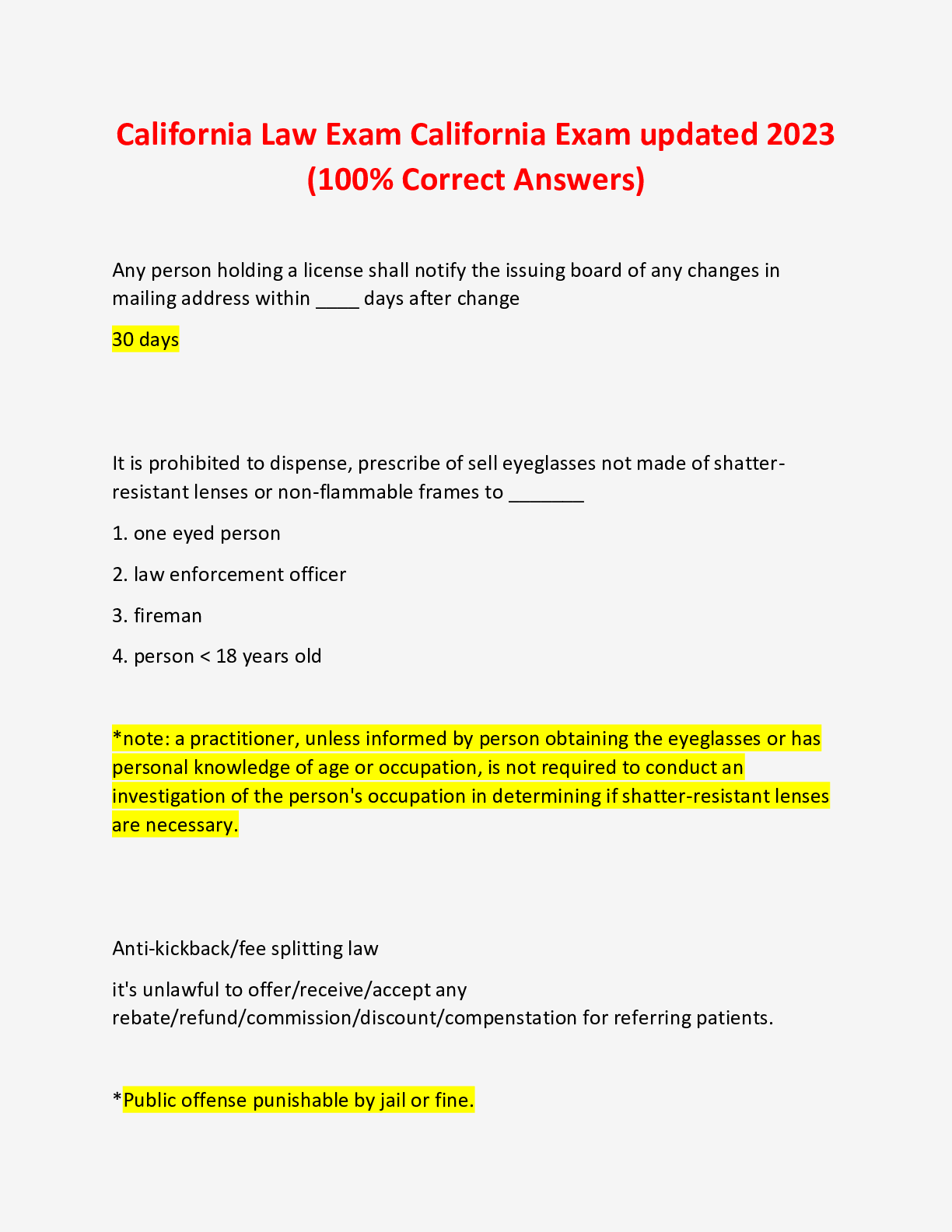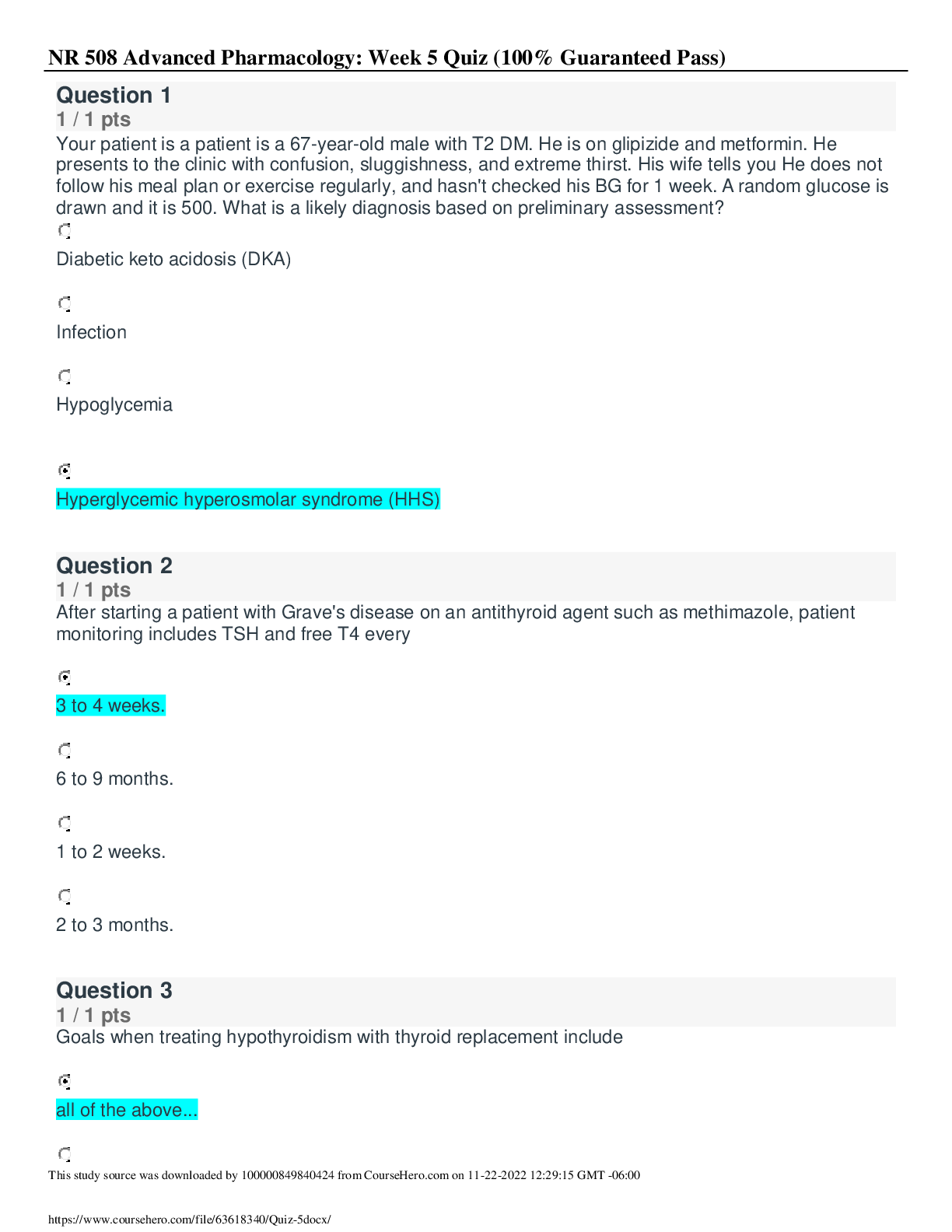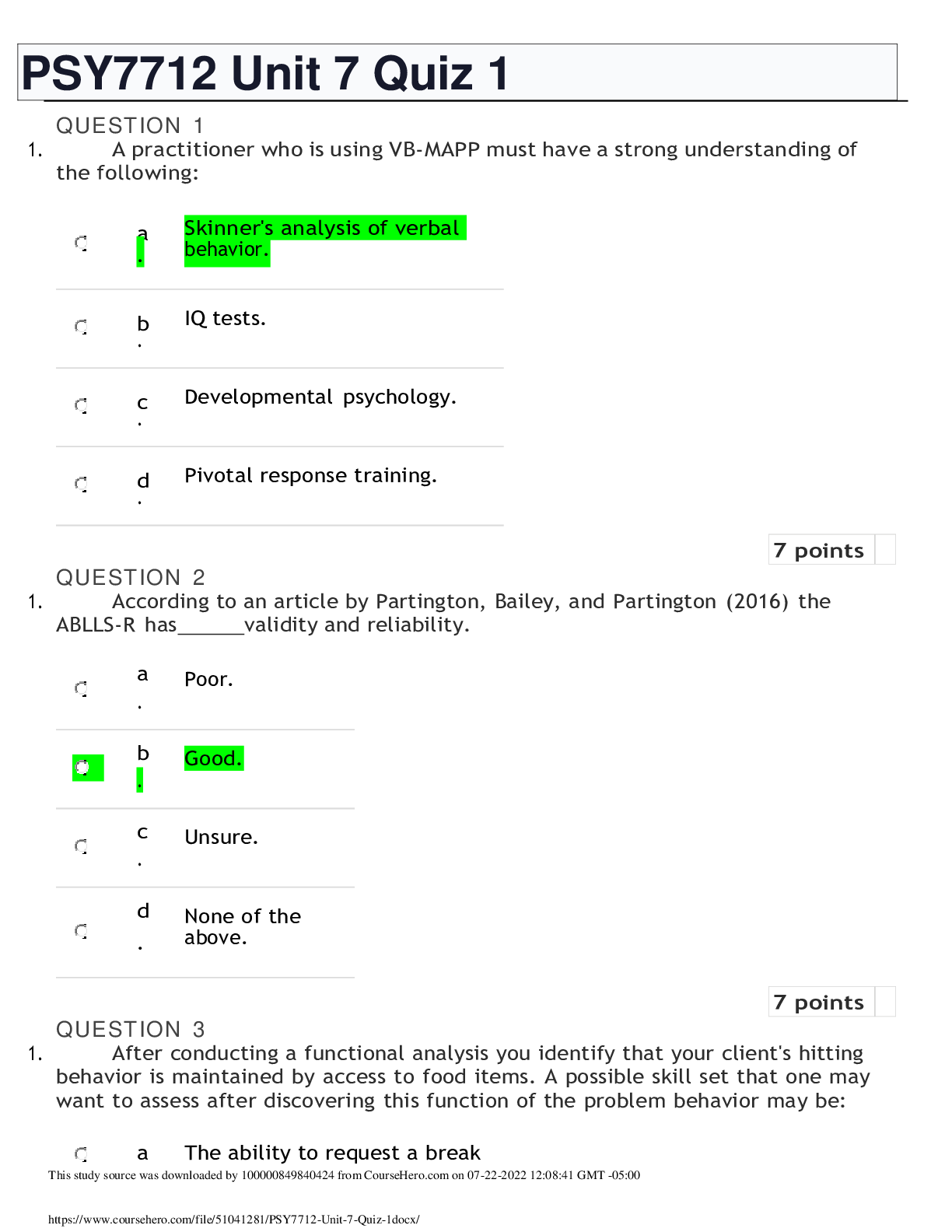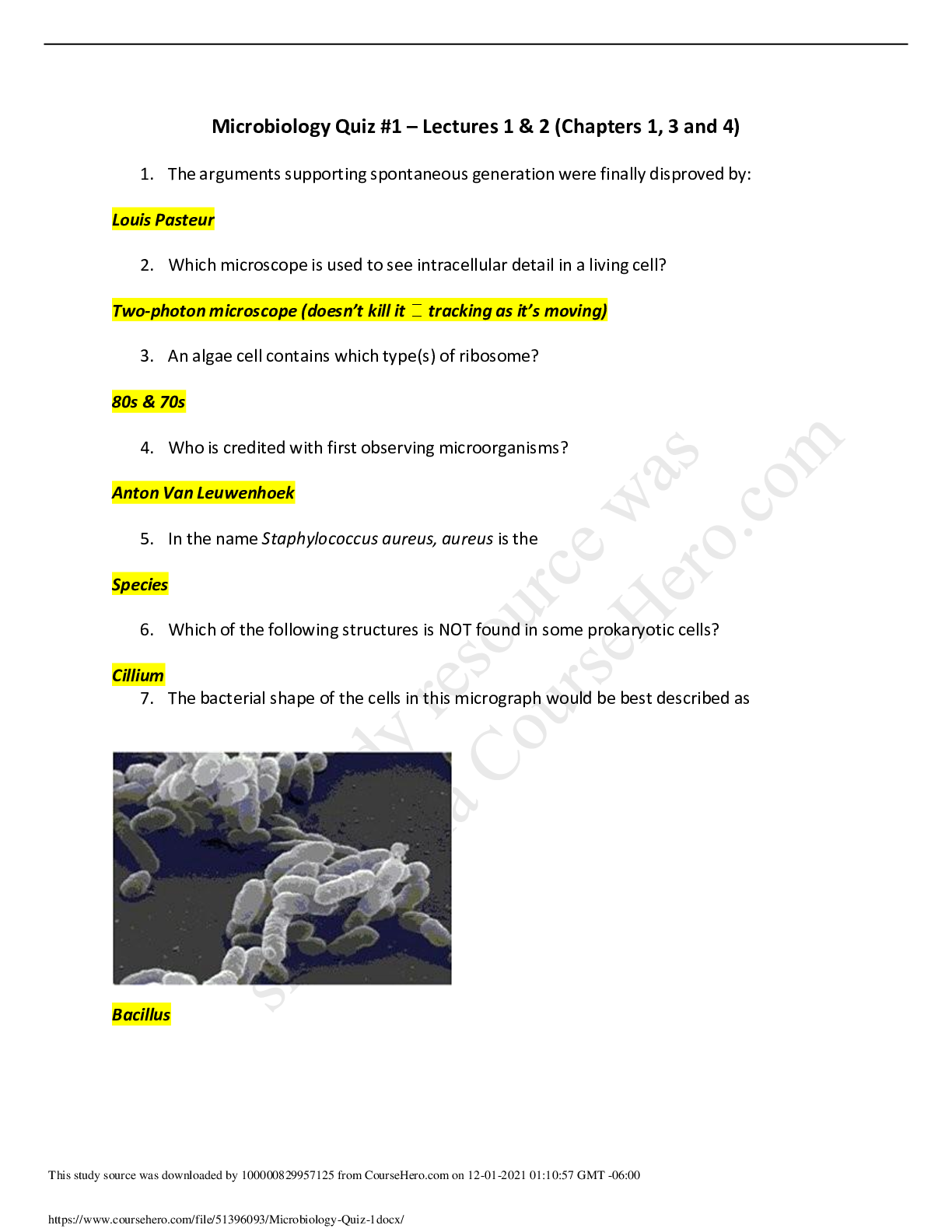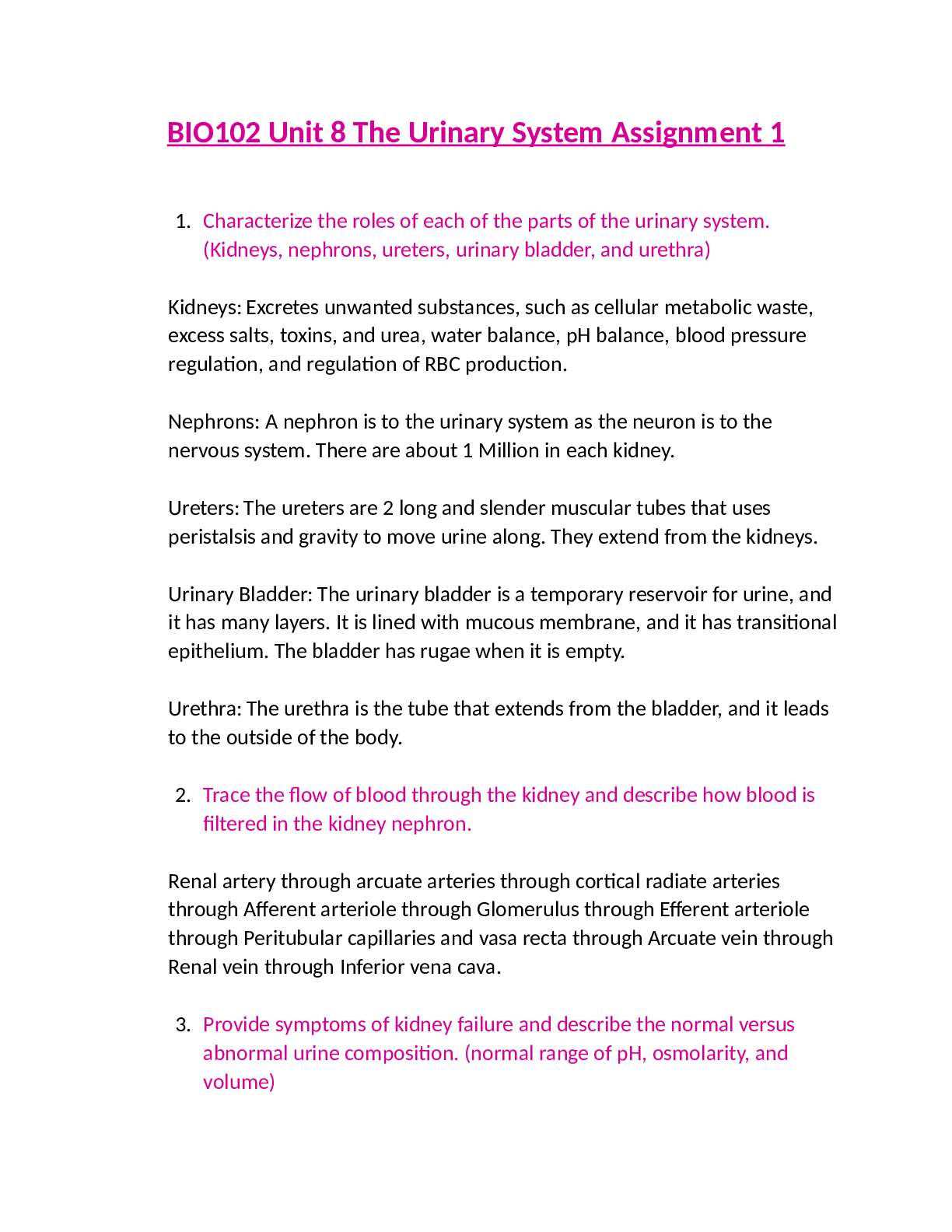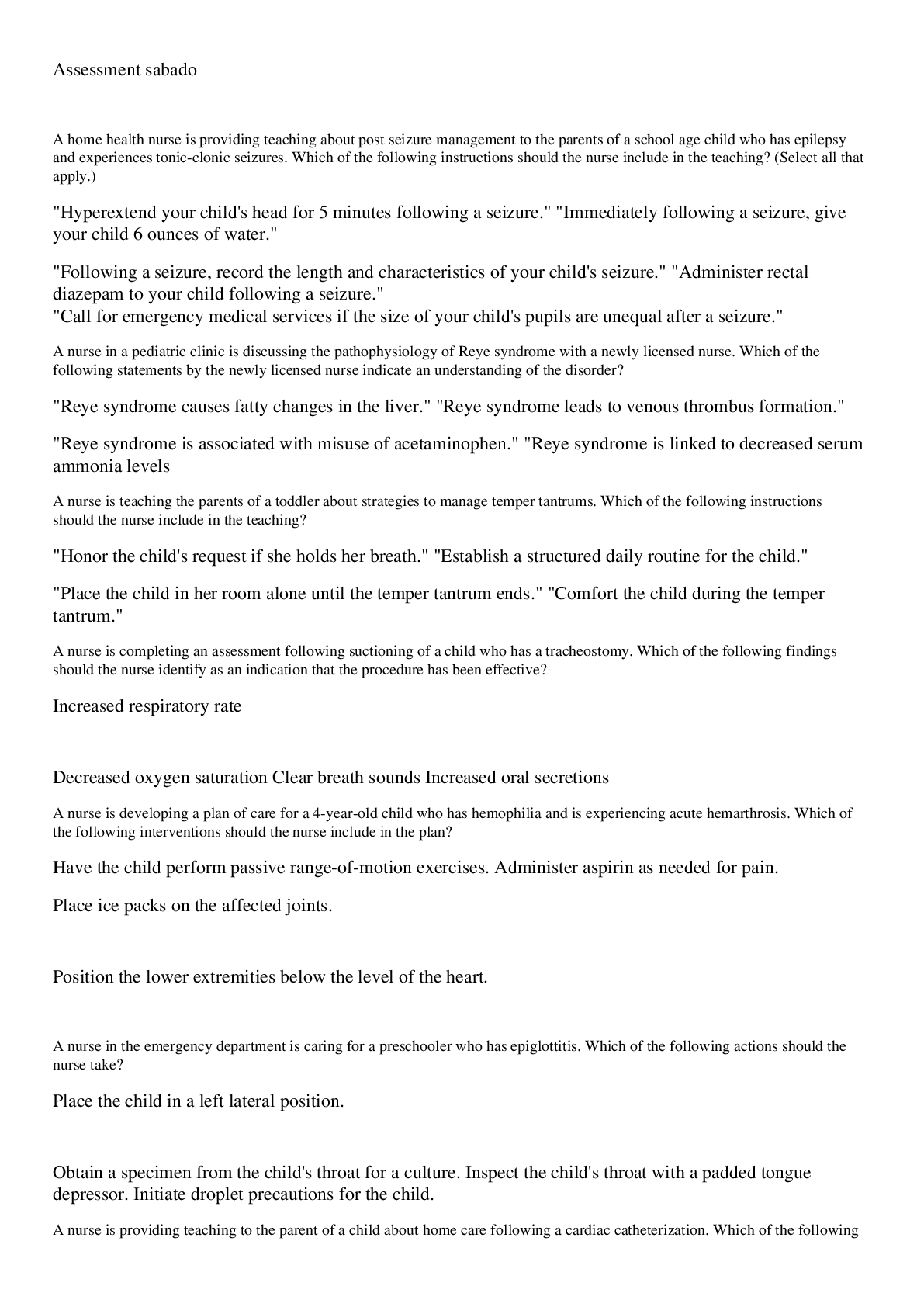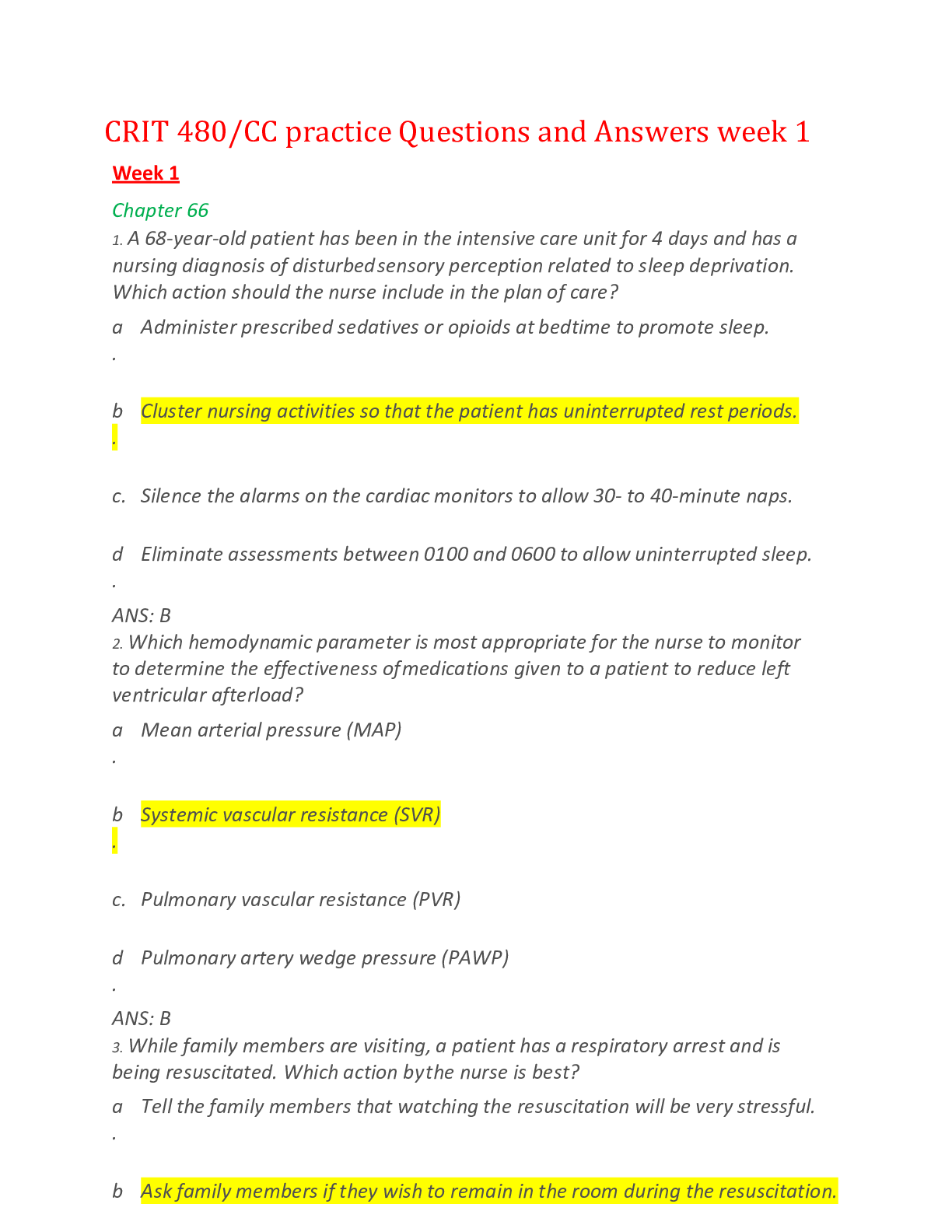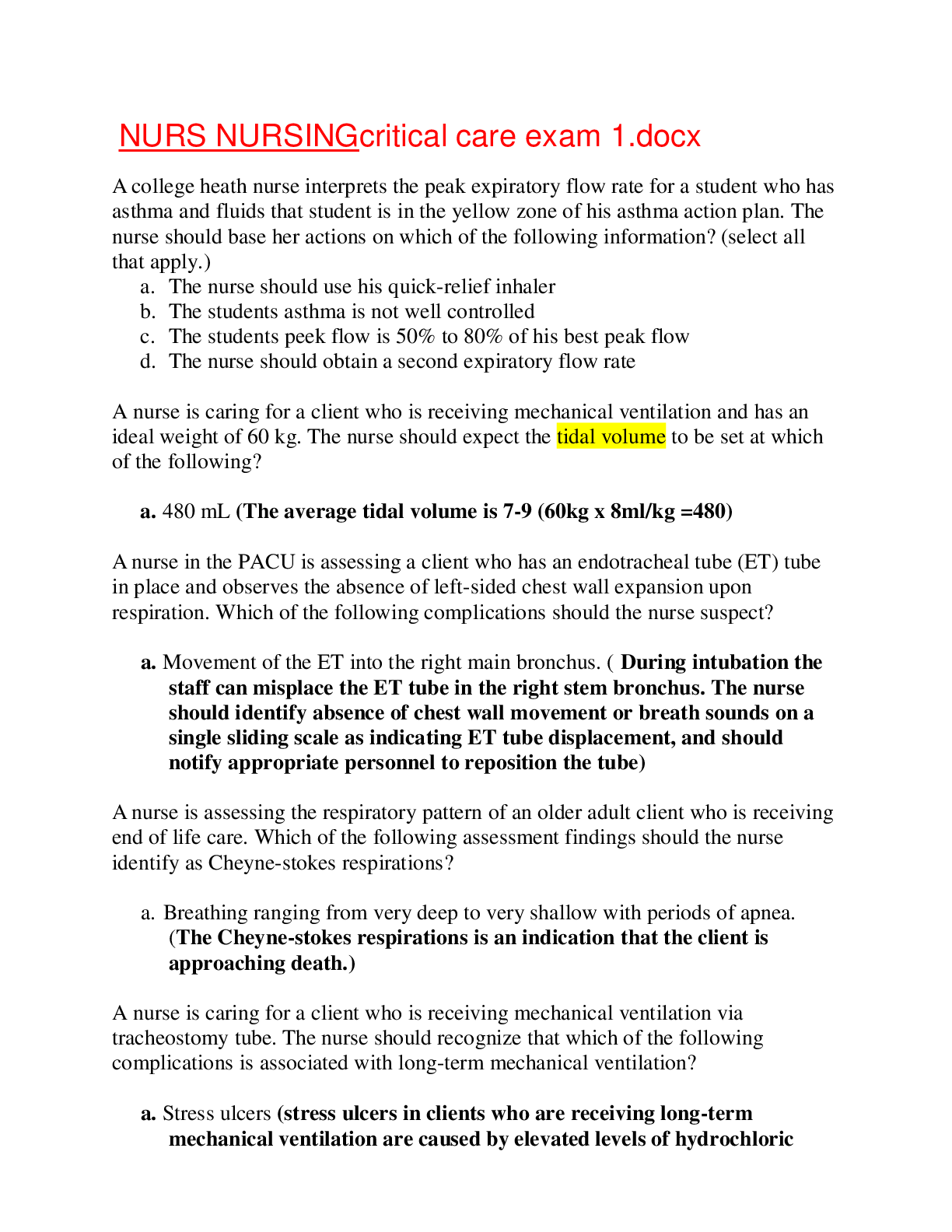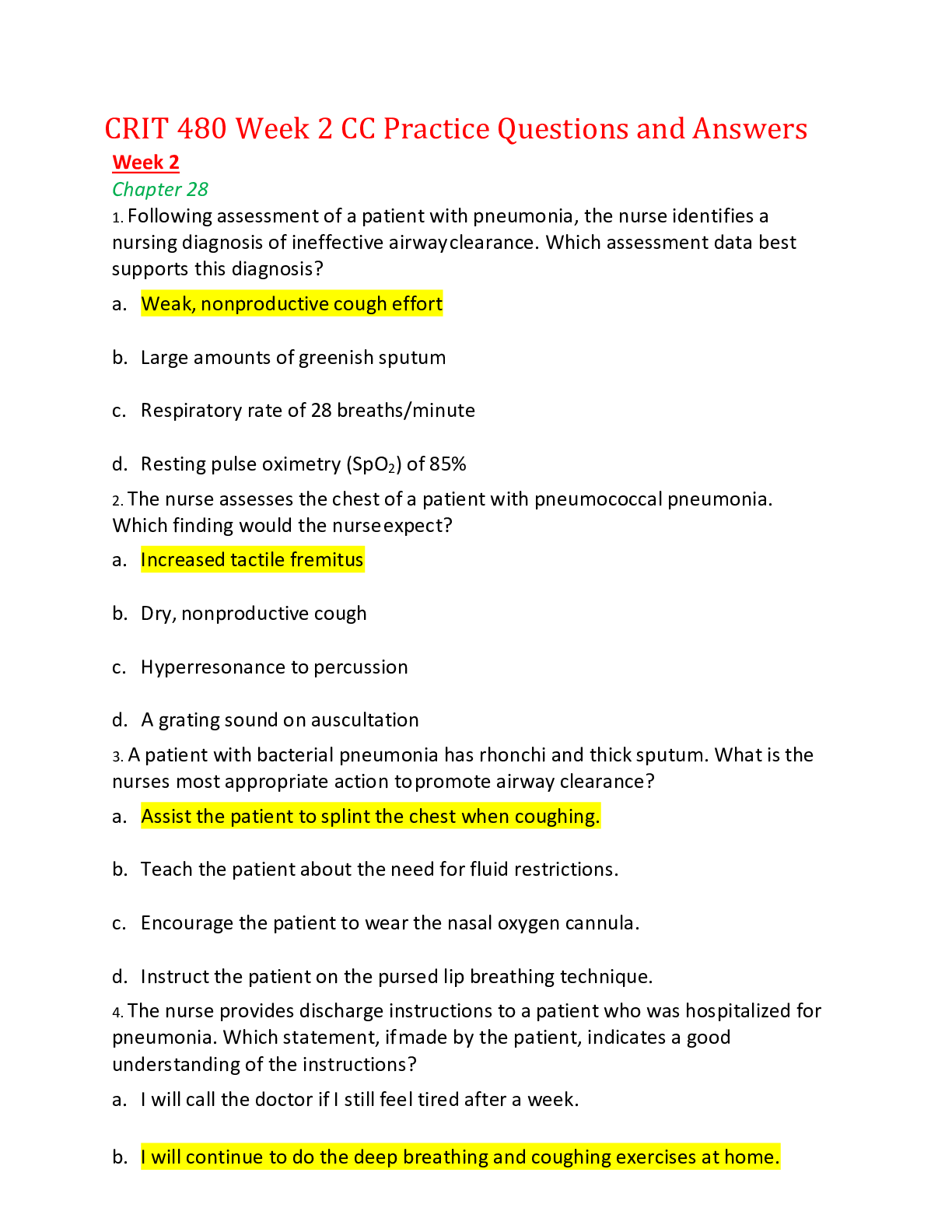BIOL 250 Unit Exam 2 (100 OUT OF 100) | American Public University
Document Content and Description Below
Unit Exam 2 Part 1 of 5 - Part 1 20.0/ 22.0 Points From chapter 3 Question 1 of 50 2.0 / 2.0 Points DNA, and the genes found on the strands of DNA, contain information necessary for synthesizin... g which type of material? • A. glucose • B. proteins • C. DNA • D. carbohydrates • E. ATP Feedback:Good work; your answer is correct! Question 2 of 50 2.0 / 2.0 Points How many bases found on a gene translate for any one amino acid? • A. One • B. Two • C. Three • D. Four • E. Five Feedback:Good work; your answer is correct! Question 3 of 50 2.0 / 2.0 Points Which of the following sequences on a DNA molecule would be complementary to GCTTATAT? • A. TAGGCGCG • B. ATCCGCGC • C. CGAATATA • D. TGCCTCTC • E. None of the above Feedback:Good work; your answer is correct! Question 4 of 50 2.0 / 2.0 Points All of the genetic material inside a cell is located in the . • A. Nucleus • B. Centrioles • C. Ribosomes • D. Golgi apparatus • E. Mitochondria Feedback:Good work; your answer is correct! Question 5 of 50 0.0 / 2.0 Points The stage of the cell cycle during which two new and fully functional nuclei are formed is called . • A. S • B. G2 • C. G3 • D. M • E. G1 Feedback:Mitosis is the division of genetic material, during which the cell nucleus breaks down and two new, fully functional, nuclei are formed. This occurs in the portion of the cell cycle labeled “M.” Question 6 of 50 2.0 / 2.0 Points The cell membrane (also called the plasma membrane) contains which of the following molecules? • A. proteins • B. cholesterol • C. phospholipids • D. glycoproteins • E. All of the above Feedback:Good work; your answer is correct! Question 7 of 50 2.0 / 2.0 Points Which of the following are organelles found inside of an animal cell? • A. nucleus • B. mitochondria • C. Golgi apparatus • D. ribosome • E. All of the above Feedback:Good work; your answer is correct! Question 8 of 50 2.0 / 2.0 Points Which type of stem cell gives rise to red and white blood cells? • A. endothelial • B. blood • C. epithelial • D. mesenchymal • E. hematopoietic Feedback:Good work; your answer is correct! Question 9 of 50 2.0 / 2.0 Points Which of the following is NOT a difference between DNA and RNA? • A. RNA is single stranded and DNA is double stranded • B. DNA contains deoxyribose and RNA contains ribose • C. DNA contains alternating sugar-phosphate molecules whereas RNA does not contain sugars • D. They have completely different functions. • E. DNA contains thymine whereas RNA contains uracil Feedback:Good work; your answer is correct! Question 10 of 50 2.0/ 2.0 Points Human sex cells (sperm or egg) contain chromosomes. All other cells contain chromosomes. • A. 23; 46 • B. 22; 44 • C. 30; 60 • D. 24; 48 • E. 25; 50 Feedback:Good work; your answer is correct! Question 11 of 50 2.0 / 2.0 Points The jelly-like substance found within cells that provides the fluid medium necessary for biochemical reactions is called . • A. Cytosol • B. Water • C. Alcohol • D. Synovial fluid • E. Petroleum Feedback:Good work; your answer is correct! Part 2 of 5 - Part 2 20.0/ 24.0 Points From chapter 3 Question 12 of 50 2.0 / 2.0 Points What is a primary function of tumor suppressor genes? • A. Allow the cell to skip certain phases of the cell cycle. • B. Help oncogenes produce oncoproteins. • C. Stop all cells from dividing. • D. Stop certain cells from dividing. Feedback:Correct. This can be found in the OpenStax Overview of Anatomy and Physiology section. Section 3.5. Question 13 of 50 2.0 / 2.0 Points Which of the following is a function of the rough ER? • A. Detoxification of certain substances. • B. Production of proteins. • C. Regulation of intracellular calcium concentration. • D. Synthesis of steroid hormones. Feedback:Correct. This can be found in the OpenStax Overview of Anatomy and Physiology section. Section 3.2. Question 14 of 50 0.0 / 2.0 Points Which of the following is NOT a role of glycocalyces? • A. Contain molecules that allow the cell to bind to other cells • B. Contain receptors for hormones • C. Prevent donated organ rejection • D. Contain enzymes to break down nutrients Feedback:Incorrect. This can be found in the OpenStax Overview of Anatomy and Physiology section. Section 3.1. Question 15 of 50 0.0 / 2.0 Points In which phase are the chromatids aligning across the center of the cell? • A. Anaphase • B. Metaphase • C. Prophase • D. Telophase Feedback:Incorrect. This can be found in the OpenStax Overview of Anatomy and Physiology section. Section 3.5. Question 16 of 50 2.0 / 2.0 Points Which nitrogenous base found in DNA and RNA pairs with guanine? • A. Adenine • B. Cytosine • C. Guanine • D. Thymine Feedback:Correct. This can be found in the OpenStax Overview of Anatomy and Physiology section. Section 3.3. Question 17 of 50 2.0 / 2.0 Points Which of the following is NOT a function of the endomembrane system? • A. Creation of plasma for cells. • B. Detoxification of poisons. • C. Metabolism and movement of lipids. • D. Synthesis of proteins and transports into membranes, organelles, or out of cells. Feedback:Correct. This can be found in the OpenStax Overview of Anatomy and Physiology section. Section 3.2. Question 18 of 50 2.0 / 2.0 Points During prophase, as the centrioles are migrating to opposite ends of the cell, their spindle fibers attach to what part of the chromatids? • A. Centromeres • B. Microtubules • C. Telomeres Feedback:Correct. This can be found in the OpenStax Overview of Anatomy and Physiology section. Section 3.5. Question 19 of 50 2.0 / 2.0 Points The strand of DNA that is continuously synthesized into the replicating fork is: • A. Double helix • B. DNA replication • C. Lagging strand • D. Leading strand Feedback:Correct. This can be found in the OpenStax Overview of Anatomy and Physiology section. Section 3.3. Question 20 of 50 2.0 / 2.0 Points What is the fluid matrix inside the cell is called? • A. Cytosol • B. Endoplasm • C. Nucleoplasm • D. Plasma Feedback:Correct. This can be found in the OpenStax Overview of Anatomy and Physiology section. Section 3.2. Question 21 of 50 2.0 / 2.0 Points Which stem cells have the most potential to differentiate into any cells needed by an organism? • A. Multipotent • B. Oligopotent • C. Pluripotent • D. Totipotent Feedback:Correct. This can be found in the OpenStax Overview of Anatomy and Physiology section. Section 3.6. Question 22 of 50 2.0 / 2.0 Points During which set of events are amino acids assembled into protein? • A. RNA processing • B. Termination • C. Transcription • D. Translation Feedback:Correct. This can be found in the OpenStax Overview of Anatomy and Physiology section. Section 3.4. Question 23 of 50 2.0 / 2.0 Points The cell membrane is composed of numerous proteins, some of which allow for passage of material in and out of the cell. Which of the following proteins allow large molecules to pass through passively? • A. Channel • B. Ligand • C. Receptor • D. Transmembrane transporter protein Feedback:Correct. This can be found in the OpenStax Overview of Anatomy and Physiology section. Section 3.1. Part 3 of 5 - Part 3 12.0/ 14.0 Points From chapter 28.7 Question 24 of 50 2.0 / 2.0 Points Marfan syndrome is inherited in an autosomal dominant pattern. Which of the following is TRUE? • A. Female offspring are more likely to be carriers of the disease. • B. Female offspring are more likely to inherit the disease. • C. Male offspring are more likely to inherit the disease. • D. Male and female offspring have the same likelihood of inheriting the disease. Feedback:Correct. This can be found in the OpenStax Overview of Anatomy and Physiology section. Section 28.7. Question 25 of 50 2.0 / 2.0 Points Which trait reappears in the second generation after disappearing in the first generation when parents with different traits are bred? • A. Hydrozygous • B. Incomplete dominance • C. Random • D. Recessive trait Feedback:Correct. This can be found in the OpenStax Overview of Anatomy and Physiology section. Section 28.7. Question 26 of 50 2.0 / 2.0 Points Mendel believed that the characteristics of pea plants are determined by which of the following? • A. Inheritance of units or factors from both parents • B. Inheritance of units or factors from one parent • C. Relative health of the parent plants at the time of pollination Feedback:Correct. This can be found in the OpenStax Overview of Anatomy and Physiology section. Section 28.7. Question 27 of 50 0.0 / 2.0 Points What is an allele? • A. A heterozygous genotype • B. A homozygous genotype • C. Another word for a gene • D. One of several possible forms of a gene Feedback:Incorrect. This can be found in the OpenStax Overview of Anatomy and Physiology section. Section 28.7. Question 28 of 50 2.0 / 2.0 Points Which Of Mendel's laws states that when any individual produces sex cells, gametes, the copies of gene separate, so that each sex cell, gamete, receives only one copy. A gamete will receive one allele or the other? • A. Incomplete dominance • B. Principle of segregation • C. Recessive trait • D. Sickle cell Feedback:Correct. This can be found in the OpenStax Overview of Anatomy and Physiology section. Section 28.7. Question 29 of 50 2.0 / 2.0 Points Zoe has cystic fibrosis. Which of the following is the most likely explanation? • A. Zoe probably inherited one faulty allele from her father, who is a carrier, and one normal allele from her mother. • B. Zoe probably inherited one faulty allele from her mother, who must also have cystic fibrosis, and one normal allele from her father. • C. Zoe must have inherited faulty alleles from both parents, both of whom must also have cystic fibrosis. • D. Zoe must have inherited faulty alleles from both parents, both of whom are carriers. Feedback:Correct. This can be found in the OpenStax Overview of Anatomy and Physiology section. Section 28.7. Question 30 of 50 2.0 / 2.0 Points Choose the genetic disorder caused by a dominant allele. • A. Hemophilia • B. Huntington's disease • C. Sickle-cell anemia • D. Tay-Sachs disease Feedback:Correct. This can be found in the OpenStax Overview of Anatomy and Physiology section. Section 28.7. Part 4 of 5 - Part 4 20.0/ 20.0 Points From chapter 4 Question 31 of 50 2.0 / 2.0 Points Which of these conduct action potentials and are the structural and functional units of nervous tissue? • A. Myelin sheath • B. Neurons • C. Oligodendrocytes • D. Schwann cells Feedback:Correct. This can be found in the OpenStax Overview of Anatomy and Physiology section. Section 4.5. Question 32 of 50 2.0 / 2.0 Points Which of the following is not a type of tissue? • A. Embryonic • B. Epithelial • C. Muscle • D. Nervous Feedback:Correct. This can be found in the OpenStax Overview of Anatomy and Physiology section. Section 4.1. Question 33 of 50 2.0 / 2.0 Points Transitional epithelium is unique in that it: • A. Expands and stretches • B. Lubricates and filtrates • C. Protects and filtrates • D. Secrets and absorbs Feedback:Correct. This can be found in the OpenStax Overview of Anatomy and Physiology section. Section 4.2. Question 34 of 50 2.0 / 2.0 Points Atrophy refers to . • A. Loss of elasticity • B. Loss of mass • C. Loss of permeability • D. Loss of rigidity Feedback:Correct. This can be found in the OpenStax Overview of Anatomy and Physiology section. Section 4.6. Question 35 of 50 2.0 / 2.0 Points Which of these is a single layer of thin, flattened cells that allow rapid diffusion or transport of substances through membrane; secretes lubricating serous fluid; found lining the air sacs of the lungs, kidneys tubules; and some other viscera? • A. Simple columnar epithelium • B. Simple squamous epithelium • C. Simple cuboidal epithelium • D. Transitional epithelium Feedback:Correct. This can be found in the OpenStax Overview of Anatomy and Physiology section. Section 4.1. Question 36 of 50 2.0 / 2.0 Points Our blood vessels are lined with muscles that allow for automatic dilation and constriction based on environmental situations. What kind of muscle tissue lines the blood vessels? • A. Cardiac • B. Skeletal • C. Smooth Feedback:Correct. This can be found in the OpenStax Overview of Anatomy and Physiology section. Section 4.4. Question 37 of 50 2.0 / 2.0 Points This cell forms myelin sheath around a segment of an axon in the peripheral nervous system. • A. Astrocyte • B. Neuroglia • C. Oligodendrocyte • D. Schwann Feedback:Correct. This can be found in the OpenStax Overview of Anatomy and Physiology section. Section 4.5. Question 38 of 50 2.0 / 2.0 Points Numerous processes, many dendrites and one axon best describe which of these? • A. Bipolar neurons • B. Multipolar neurons • C. Myelin • D. Nerve cells Feedback:Correct. This can be found in the OpenStax Overview of Anatomy and Physiology section. Section 4.5. Question 39 of 50 2.0 / 2.0 Points Which of these tissues is composed of layers of closely spaced cells that cover organ surfaces, form glands, and serve for protection, secretion, and absorption? • A. Connective tissue • B. Epithelial tissue • C. Muscular tissue • D. Reticular tissue Feedback:Correct. This can be found in the OpenStax Overview of Anatomy and Physiology section. Section 4.1. Question 40 of 50 2.0 / 2.0 Points Which of the following is NOT released during inflammation? • A. Cytokines • B. Irritants • C. Prostaglandins • D. Proteins Feedback:Correct. This can be found in the OpenStax Overview of Anatomy and Physiology section. Section 4.6. Part 5 of 5 - Part 5 20.0/ 20.0 Points From chapter 4 Question 41 of 50 2.0 / 2.0 Points Simple epithelium appears under a microscope like scales. They usually lie flat and horizontal. • A. columnar • B. cuboidal • C. stratified • D. squamous • E. junctional Feedback:Good work; your answer is correct! Question 42 of 50 2.0 / 2.0 Points The following types of tissue all are part of the category named muscle tissue: • A. Skeletal muscle • B. Smooth muscle • C. Cardiac muscle • D. Visceral muscle • E. A, B, and C are all correct. Feedback:Good work; your answer is correct! Question 43 of 50 2.0 / 2.0 Points The different types of cells are not randomly distributed throughout the body; rather they occur in organized layers, a level of organization referred to as . • A. epithelial • B. a cell system • C. an organ system • D. tissue • E. an organ Feedback:Good work; your answer is correct! Question 44 of 50 2.0 / 2.0 Points Which of the following statements is/are true about nervous tissue? • A. A neuron is able to propagate nerve impulses. • B. A neuroglial cell is a supportive cell. • C. The cell body of a neuron is called the soma. • D. All of the above statements are true. • E. Only A and B are true. Feedback:Good work; your answer is correct! Question 45 of 50 2.0 / 2.0 Points According to your author, which of the following functions of connective tissue is its most important function? • A. forming glands • B. protection • C. support and connect other tissues • D. transport of fluid, nutrients, waste • E. energy storage Feedback:Good work; your answer is correct! Question 46 of 50 2.0 / 2.0 Points The large sheets of cells covering all the surfaces of the body exposed to the outside world and lining the outside of organs are all called tissue. • A. epithelial tissue • B. lining tissue • C. covering tissue • D. mesoderm tissue • E. skin tissue Feedback:Good work; your answer is correct! Question 47 of 50 2.0 / 2.0 Points Cells of the body are organized into broad categories of tissue. • A. two • B. three • C. six • D. five • E. four Feedback:Good work; your answer is correct! Question 48 of 50 2.0 / 2.0 Points The embryonic tissue level, mesoderm, gives rise to which of the following type(s) of tissue? • A. Skin cells • B. Neurons • C. Skeletal muscle • D. Thyroid cells • E. All of the above Feedback:Good work; your answer is correct! Question 49 of 50 2.0 / 2.0 Points Striations, cylindrical cells, and multiple nuclei are observed in . • A. skeletal muscle only • B. cardiac muscle only • C. smooth muscle only • D. skeletal and cardiac muscles • E. all three types of muscle Question 50 of 50 2.0 / 2.0 Points The basic types of cell-to-cell junctions between epithelial cells are . • A. Tight junctions • B. Gap junctions • C. Anchoring junctions • D. Fixed junctions • E. A, B, and C are all correct. Feedback:Good work; your answer is correct! [Show More]
Last updated: 1 year ago
Preview 1 out of 37 pages

Reviews( 0 )
Document information
Connected school, study & course
About the document
Uploaded On
Aug 08, 2022
Number of pages
37
Written in
Additional information
This document has been written for:
Uploaded
Aug 08, 2022
Downloads
0
Views
48



.png)










